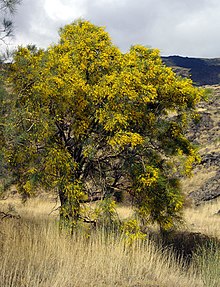Genista aetnensis, the Mount Etna broom,[2] is a species of flowering plant in the legume family Fabaceae. It is a large shrub or small tree endemic to Sicily and Sardinia where it is associated with sunny, open landscapes and poor, stony soil. It is a very common constituent of the garigue plant communities, Mediterranean shrubby vegetation, around the lower slopes of Mount Etna, hence its Latin specific epithet aetnensis.[3]
| Genista aetnensis | |
|---|---|

| |
| Scientific classification | |
| Kingdom: | Plantae |
| Clade: | Tracheophytes |
| Clade: | Angiosperms |
| Clade: | Eudicots |
| Clade: | Rosids |
| Order: | Fabales |
| Family: | Fabaceae |
| Subfamily: | Faboideae |
| Genus: | Genista |
| Species: | G. aetnensis
|
| Binomial name | |
| Genista aetnensis | |
The young plant is typical of brooms, clothed in narrow linear leaves which soon drop off leaving almost bare branches. As it ages the shrub develops into a shapely small tree with a greenish bark, growing to 8 metres (26 ft) if given room to develop. The terminal branches have a tendency to droop and weep. Abundant pea-like, yellow, jasmine-scented flowers cover the whole crown in late summer.[4]
It is sometimes grown in gardens and landscaping, both for flower and for its attractive shape when mature. It is hardy down to −15 °C (5 °F). In cultivation in the UK it has gained the Royal Horticultural Society's Award of Garden Merit.[5][6]

See also
editReferences
edit- ^ Rivers, M.C.; Beech, E. (2017). "Genista aetnensis". IUCN Red List of Threatened Species. 2017: e.T79727282A79727286. doi:10.2305/IUCN.UK.2017-3.RLTS.T79727282A79727286.en. Retrieved 20 November 2021.
- ^ BSBI List 2007 (xls). Botanical Society of Britain and Ireland. Archived from the original (xls) on 2015-06-26. Retrieved 2014-10-17.
- ^ Harrison, Lorraine (2012). RHS Latin for Gardeners. United Kingdom: Mitchell Beazley. ISBN 978-1845337315.
- ^ RHS A-Z encyclopedia of garden plants. United Kingdom: Dorling Kindersley. 2008. p. 1136. ISBN 978-1405332965.
- ^ "Genista aetnensis". RHS. Retrieved 9 July 2020.
- ^ "AGM Plants - Ornamental" (PDF). Royal Horticultural Society. July 2017. p. 42. Retrieved 27 February 2018.
- Media related to Genista aetnensis at Wikimedia Commons
